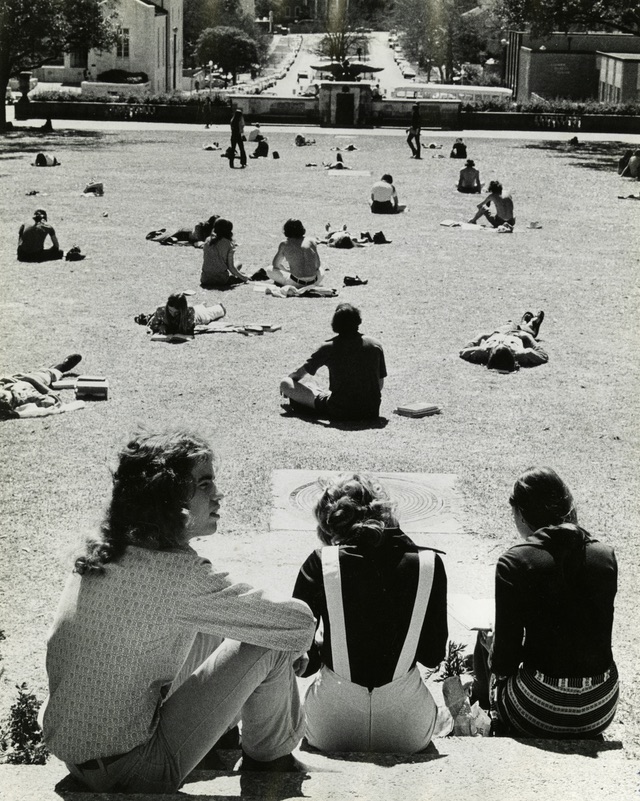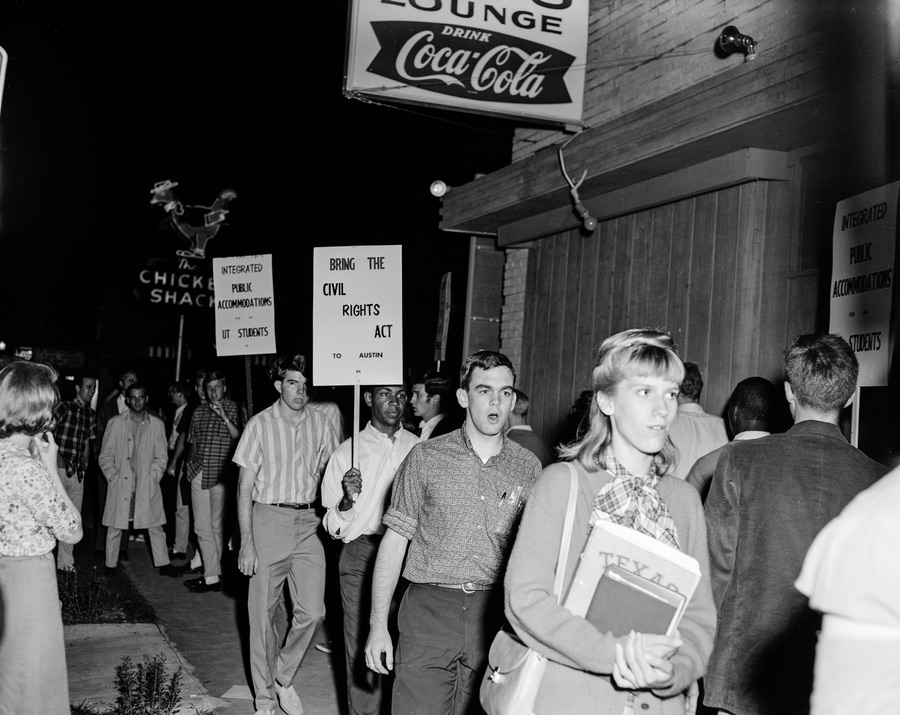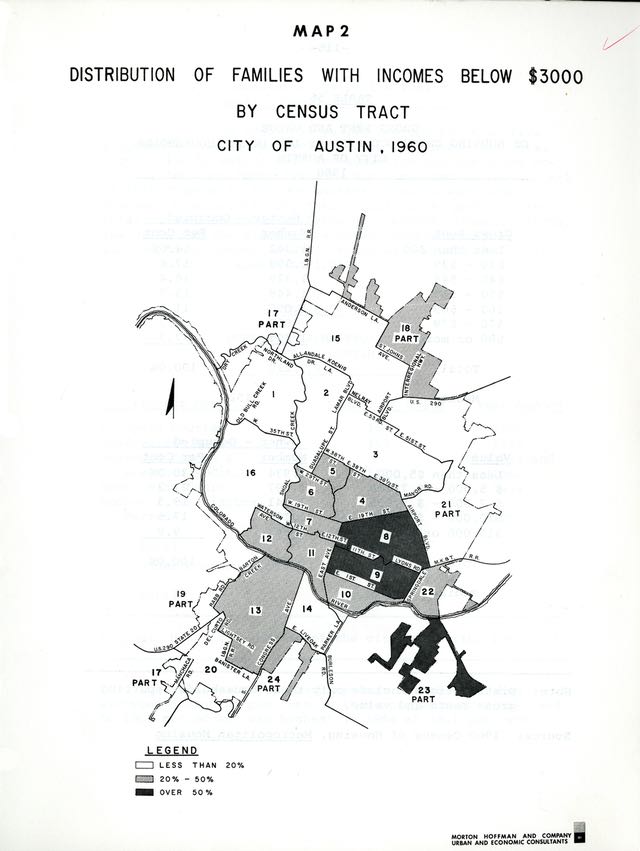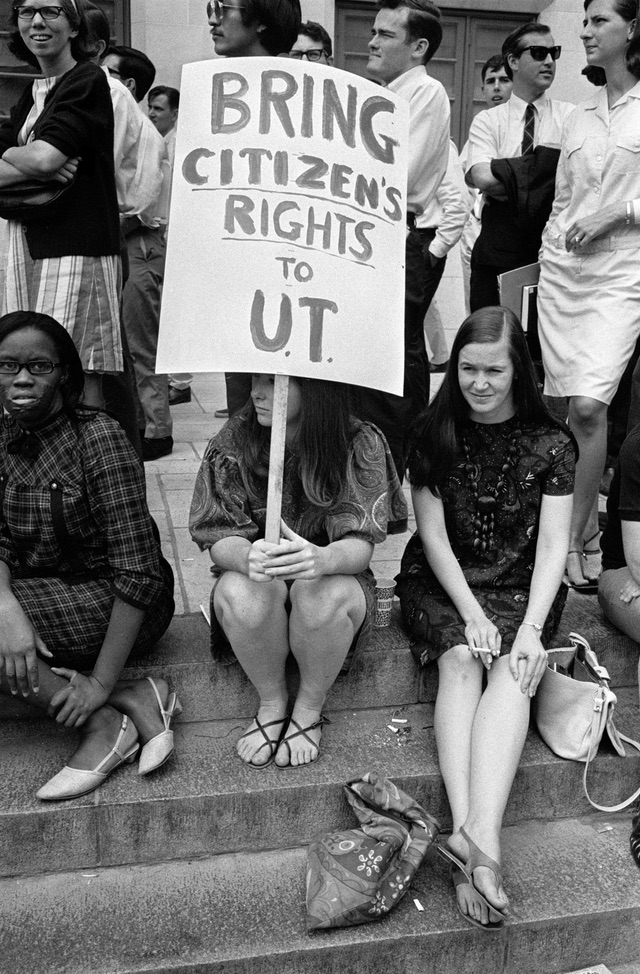College life at UT Austin changed in 1956 when the Board of Regents decided to accept the first African-American students. In addition to the tense race relations that resulted, tuition was rising, university housing was increasingly scarce, and there was growing student activism that challenged the UT Board of Regents and openly protested against US involvement in Vietnam. The tower shooting may not have been directly related to these turbulent events, but it occurred against the backdrop of a rapidly changing world in the 1960s.

Young UT Students in the Sixties at Main Mall. Image courtesy of Dolph Briscoe Center for American History
Race and Civil Rights
Since 1956, racial segregation was coming to an end. In the fifties, Hispanic and African-American movements across America mobilized and demanded the recognition of civil rights equal to those of white Americans. In the Southern states, the African-American movements aimed to end Jim Crow laws and seek fulfillment of the U.S. Supreme Court decision to end the “segregated but equal” education system.
The Supreme Court stipulated that each state had to decide how to desegregate public schools.1 In 1956, the UT Board of Regents designed a plan to regulate the enrollment of African-American students and determine the spaces they could access on campus.
In 1960, African-American student groups actively protested against the housing policy that allowed black students to apply to only five of eleven university-operated dormitories on campus and against regulations that banned their participation in athletic and artistic competitions representing UT.2 Slow changes implemented by the Board of Regents, led to the creation of a student group called “The Students for Direct Action.” Between 1960 and 1963, “The Students for Direct Action,” and “Negroes for Equal Rights” organized sit-ins in restaurants and movie theaters close to campus that refused to serve black people. Students also sent letters to the Board of Regents demanding full desegregation. The sit-ins had the support of many white students. which helped the protestors receive media coverage and strengthen their call for an end to racial segregation.”3
In 1963 the Campus Interracial Committee called for the immediate and complete integration of university housing, athletics, and jobs, sending a letter to the Board of Regents. Finally, on November 9, 1963, the Board decided to “remove all student restrictions of every kind and character based on race or color.”4
The full integration of African-American students represented a partial victory for the Civil Rights movement at UT. The desegregation of campus spaces and opportunities increased the demand for university-owned housing which had an adverse impact on students’ finances independent of their color.

UT Students protesting the segregation policies at Austin restaurants. Image Courtesy of Dolph Briscoe Center for American History
Student Finances
In 1957, the Texas Commission on Higher Education proposed an increase of 150% in tuition to guarantee the funding of Texas public universities. The Texas Legislature approved a tuition increase for the academic year 1960-1961. In-state tuition for the nine-month long school year was $100, plus $36 in other fees and, out-of-state tuition was $400 plus $36 in other fees.5
The increased tuition added financial pressures to low-income families trying to access higher education. For the academic year 1960-1961, in addition to the $136 in tuition, a student had to pay an average of $1,200 to cover rent and miscellaneous expenses for the nine-month session.6 In 1961, the minimum wage was $1 per hour. One dollar in the sixties, is equivalent to approximately $7.40 today.7
The Southern Regional Education Board analyzed the impact of increased tuition and living costs on people´s possibilities to access higher education. They found that 80 percent of those from families with income above the $12,000 level entered college, but only 48 percent of those from families with incomes below $3,000 a year went to college. This situation increased competition for the limited financial aid and student loans offered by the State of Texas and The University of Texas.8
Despite the raised tuition, young people were encouraged to attend college instead of aiming for a full-time job after high school graduation, because “what better way is there to finish the maturing process that in an Ivory Tower?”9 Since 1957, the number of enrolled students at UT increased at a rate of 1,000 students per academic year. Between 1964 and 1966, the number of students rose from 26,329 to 27,345.10
The increasing number of students had an adverse impact on the university-owned housing services. In 1964, UT was only capable of providing housing to approximately 20% of enrolled students’. Privately owned housing was more expensive, with rent ranging from $30 to $90 a month, compared with rents in university residences that ranged from $18 to $45 a month for single accommodations.11 The housing situation was even more difficult for African-American students. In 1964, African Americans still were not able to apply to the five university-owned complexes, making the black fraternity and sorority houses the only alternative for on-campus housing.12
Increasing housing costs and the lack of university-owned housing for undergraduate and graduate students, influenced the decision by the Board of Regents to approve the construction of low-cost houses in the Brackenridge complex close to Lake Austin in 1965, to “take care of those who are struggling with financial problems but who are equally entitled to a public education and who should be among the leaders of the destiny of our future.”13

Distribution of Families with Incomes Below $3000, Austin 1960. Morton Hoffman & Company. Housing Market Analysis, Austin Texas, 1965-1985: Report prepared for the Austin Community Development Program. Image courtesy of Austin History Center, Austin Public Library
Increasing living expenses had a significant impact on married students. In 1965, one-third of the 26,230 students at UT Austin were married. They competed to live in one of the 767 university-owned apartments, where they would pay $25.75 for a one bedroom accommodation or $40.75 for two bedrooms.14 Part-time jobs were an option to cover expenses, however, on-campus jobs only paid between $1.30 and $2 an hour.15 In 1966, the per capita income in Austin was $2,21216 in comparison with the national average salary which was $2,500.17 A study by Metropolitan Austin showed that in 1965 family expenses averaged $4,425 with an annual inflation of 1.4 percent.18
This situation led some UT faculty and administrators to characterize college couples as “impulsive, unwise, irresponsible, and doomed to failure.” In some of these couples, the wife earned more money than her husband, which was also negatively perceived in the sixties, as it “may rob the boy of his feeling of manhood and independence.”19
Student Activism
UT Austin was one of many college campuses in the U.S. with active student movements that regularly had public demonstrations against racism, social and economic inequalities, and the Vietnam War. From 1964 to 1969, one of the most active students groups was the “Students for a Democratic Society” or SDS.
SDS was a student organization, created as a branch of the League for Industrial Democracy. The first SDS meeting was held in Ann Arbor, Michigan in 1962 with an attendance of fewer than 100 people.20 After this first session, SDS expanded to college campuses across the US, due in part to student opposition to the escalation of U.S. involvement in Vietnam.21
The UT SDS chapter was established in 1964 by five students. In 1964, SDS supported the protests of black activists against segregated housing on campus and services around the university. SDS participated in the black students’ sit-ins on Guadalupe (The Drag) in restaurants and cinemas that refused to serve black students. Also, SDS actively reinforced the Campus Interracial Committee (CIC) petition, calling for the full integration of African-American students in all UT activities, academic spaces and, the end of the housing segregation.22
SDS not only supported the end of racial segregation on campus, but the group also protested against the working conditions some part-time jobs offered to UT students. In 1965, they protested against the “Chuckwagon,” a café located in the Texas Union that paid $1.30 working part-time. SDS staged a sit-in at the restaurant, occupying it for four hours without ordering, demanding the contractor pay $2.00 an hour minimum wage. They also demanded and that blacks and Chicanos be hired in the Office of Food Services.23 The Texas Union was one of the most active places on campus for student life in the sixties, as it hosted The University of Texas Student Assembly, and places like Cactus Cafe, the Bowling Alley, and many restaurants.24
SDS leaders advocated for non-violent mobilization on campus and in Austin to avoid the response of public authorities. The UT Board of Regents supported student expression as long as students’ actions did not interfere with the orderly conduct of authorized University functions.25 Some people at UT believed that SDS protests were sponsored by communist cells in the USA. However, Willard D, (Scott) Pittman, one member of the local chapter argued that “there certainly is no evidence that SDS takes orders from Moscow or Peking.”26

UT students protesting for the inclusion of Civil Rights at UT. Image courtesy of Dolph Briscoe Center for American History
Relations between UT officials and the SDS were complicated, as protests against the Vietnam War generated bad press for the university. After each protest, there were ongoing disciplinary proceedings against SDS leaders. One of the most significant challenges UT administrators faced was in 1965 when 150 students protested at the Texas Capitol against the war in Vietnam. President Ranson had not approved that protest and SDS was dropped from the list of organizations allowed to hold meetings on campus.27
The Student Religious Liberals and University Socialist Committee and the University of Texas Student Assembly reacted against the proscription of SDS considering it an infringement of the right to free speech.28 The Texas Legislature in 1967 decided to strengthen the power of the campus police because of a “dismaying increase in crime,” and allowed campus police to arrest students if they were disturbing college environment.

Students for a Democratic Society [SDS] UT chapter protesting for the Vietnam War. Image courtesy of Dolph Briscoe Center for American History
Students´ life at UT in the first part of the sixties was not “pristine” or “carefree.” The reality was more complex. Changes taking place elsewhere in the United States and in Austin helped create a student-body that contested traditional conceptions of race relations, gender roles, and personal morality,29 and protested government policies, especially in Vietnam.30 On campus student organizations like the SDS, Negroes for Equal Rights, and sororities and fraternities for black and white students, helped individuals mobilize for such public activities. The majority of UT students probably never participated in a rally or protest against the war in Vietnam, but no one could fail to notice the changes occurring on campus regarding student finances, race relations, and national politics.


